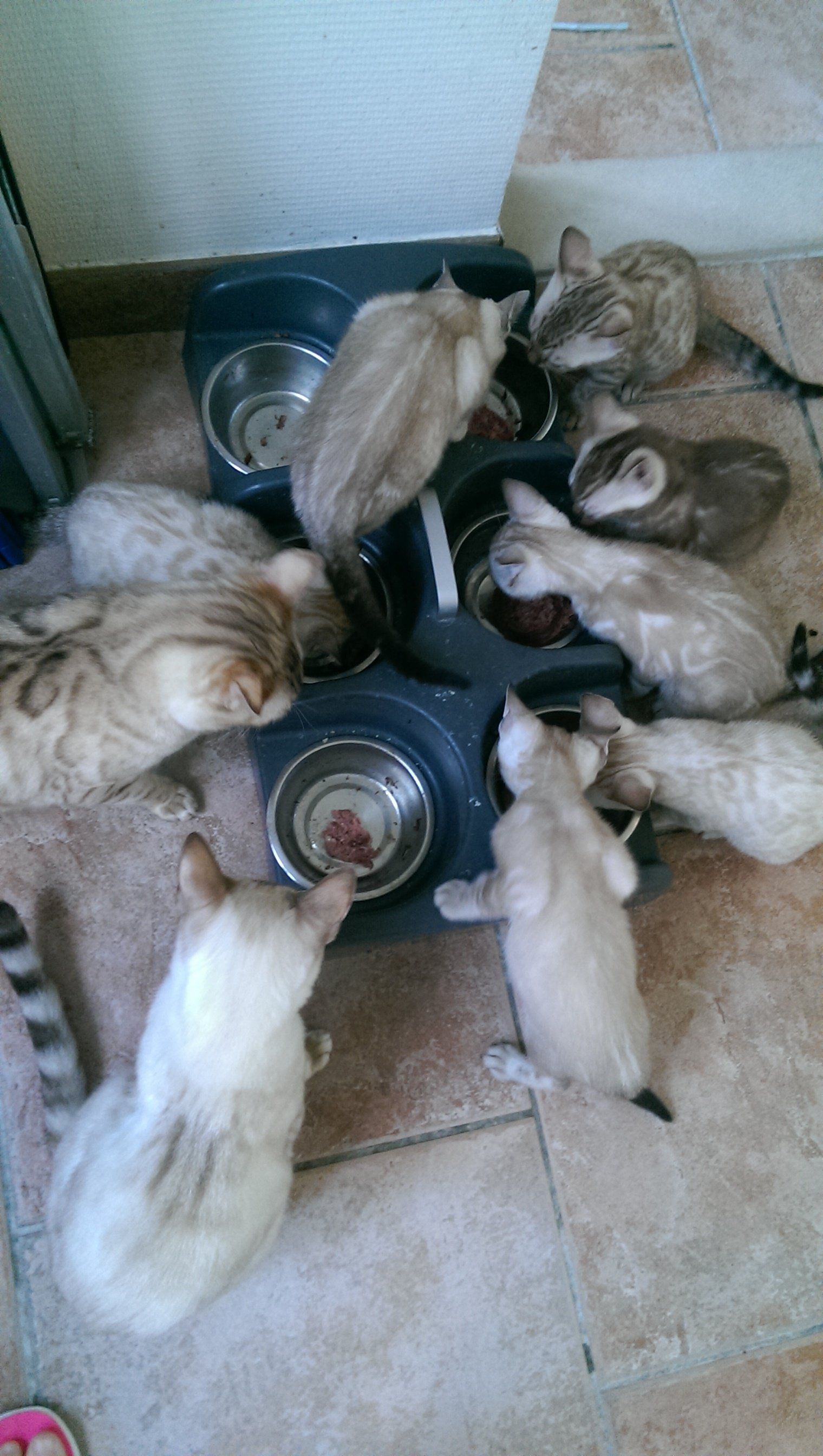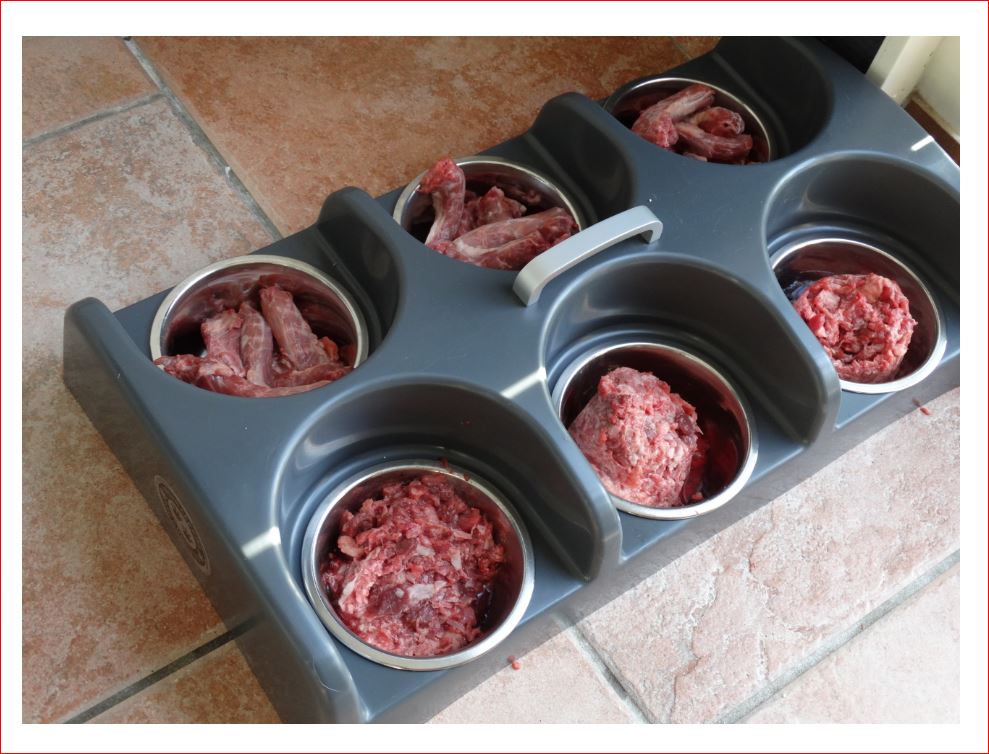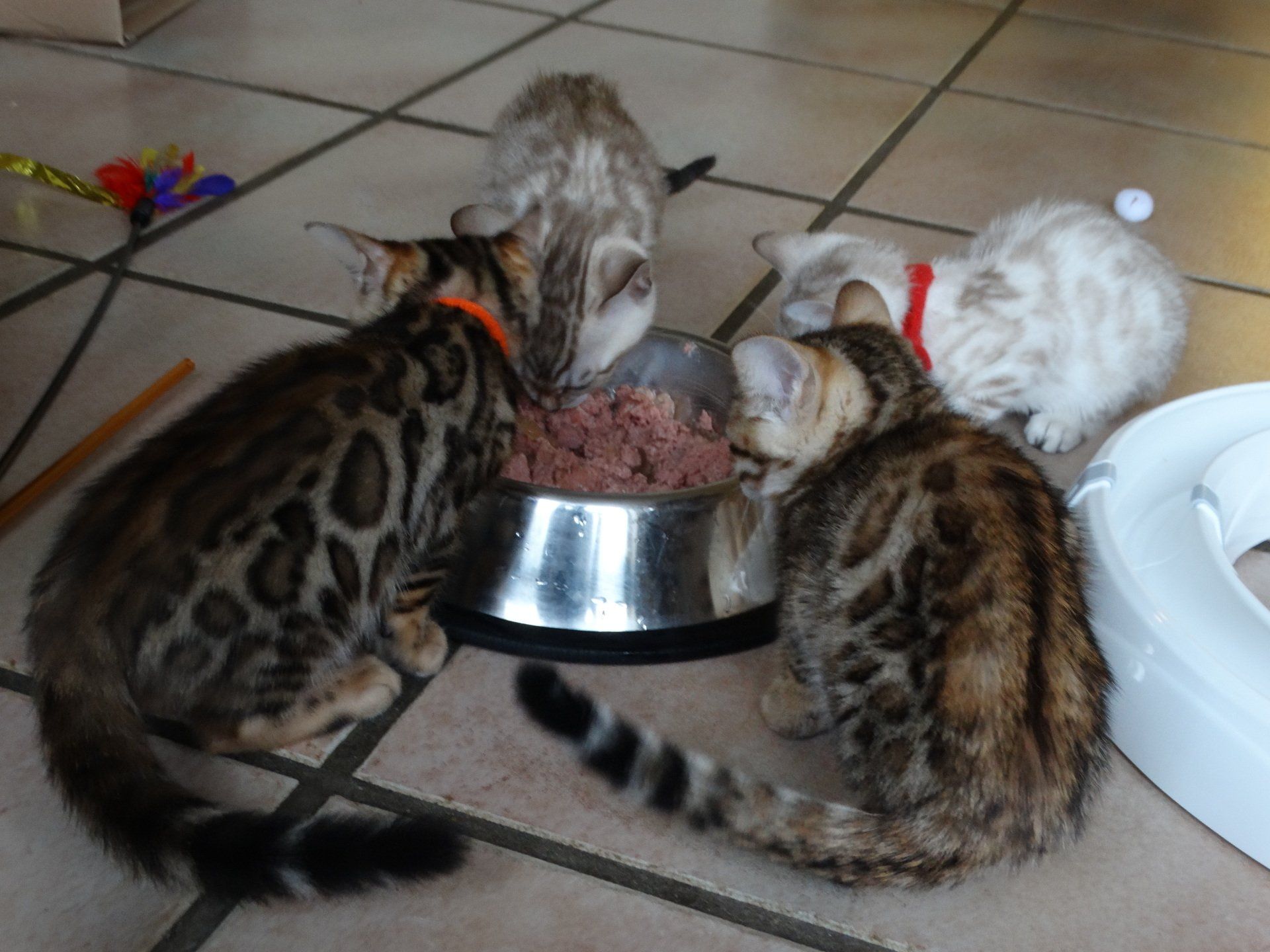Food - CDV
Food - CDV
Raw food Our cats and kittens are mainly used to meat as food. They are raised on raw food also called KVV. Kvv stands for “ready-to-eat fresh feed”. Our kittens learn to eat beef tartare as the first solid food. Beef tartare is very easy to digest and it helps to build up the intestinal flora. When they are used to this, we switch to ground beef. This is basically the same, only slightly fatter and therefore harder to digest. When this goes well, we teach them to eat various flavors. You can find the Chamber of Commerce on various websites, but nowadays also at points of sale and in pet stores. When you look around you will notice that there are several brands available. We ourselves carry the brands Barfmenu and Kiezebrink. The difference between Barfmenu and Kiezebrink is mainly the price. In addition, Barfmenu has a role that is “complete”. You can therefore give this "taste" daily without the cats becoming deficient. Kiesebrink does not have this. The flavors at Kiezebrink are simple and must therefore be varied. The flavors we give are;
Barfmenu (formerly tinlo) Cattery | available in 500 gram and 1 kg rolls. Barfmenu also has small rolls of 250 gram in loose flavors (so alternate), but this also includes the fish flavor. Fish may of course be given, but it is not popular among our cats. Fish also has a lesser side effect, it is laxative. Some cats react a lot to it so always pay attention to the percentages of fish.
Kiezebrink Kiezebrink mix chicken | available in 1 kg rolls Kiezebrinkmix chicken-bone | available in 1 kg rolls of Kiezebrinkmix duck | available in 1 kg rolls and 500 grams of kiezebrink mix rabbit | available in 1 kg rolls and 500 grams of kiezebrink mix turkey | available in 500 gram rolls We regularly give day-old roosters, chicken or lamb hearts and duck necks. So if a cat weighs 3 kg, it is 3x35 = 105 grams per day. Kittens are allowed unlimited food until they are 1 year old because they are growing. Of course, their weight should always be taken into account. Too heavy is never good, but the guideline of 35 grams of meat per kilogram of body weight will not be enough for their growth. Therefore, adhere to the guideline from 1 year. With simple flavors it is necessary, as mentioned earlier, to alternate in order to prevent shortages. Try to feed 4 to 5 flavors over a period of 3 to 4 weeks. Feeding the same flavor for 1 week is possible without any problems, but care must of course be taken. When feeding other brands, care should be taken whether they are suitable for cats. This is because taurine is added for cats. You could possibly compensate for this by adding some hearts once a week because this contains a high level of taurine. There is also often tripe in dog food. Tripe is not eaten by cats. Also pay attention to the percentage of fish because this can have a laxative effect just like too much organ. When switching to another brand, it can therefore take some searching. Therefore, do not buy too many of a new brand or flavor at once until you know that they tolerate it well. Buy the rolls frozen and store them in the freezer. do not leave the meat out of the fridge for too long (especially in warm weather) As a snack, you can also give the cats day-old chicks, mice and, for example, chicken necks. We mainly feed ourselves in the evening. When the kittens are small, this is of course spread over the day. Later, feeding once or twice a day is sufficient. The advantage of this is that they eat the meat almost immediately. It remains a raw product that must be handled with care. If it stays too long, take it away (put it in the fridge) and offer it again later. Myths about feeding meat and worms We regularly hear the question whether the fur of raw meat is not bad for cats because of the risk of worms. The digestion of a cat that eats raw meat is different from a cat that eats kibble. This already starts in the stomach. Gastric juice from a cat that eats fresh meat is more acidic. The pH is different. It starts in the stomach with the elimination of bacteria, possible worms or parasites, while these can penetrate further into the body in a cat that eats kibble. Of course, a worm infestation also occurs in a carnivorous cat and raw food should always be handled with care. But a cat that eats fresh meat does not run a greater risk (possibly even less) of a worm infestation than a cat that eats kibble.
Why do we choose raw feeding? After trying countless things myself with my own cats and after time and again new laboratory tests, I had had enough. Every vet saw that something was not quite right with the stools of our cats, but according to all tests they were / are perfectly healthy. Diet food here, other kibble there, all this made no difference or the (stool) problem only got worse. When the vet again recommended the first type of diet food after a series of tests, I was completely fed up. When they got home, put the chunks aside and started with BARFmenu and raw food from Kiezebrink. It's amazing how quickly a cat can get rid of this food. They love it! The cats and kittens got more energy after 1 day, were playing, came to ask for attention a lot more. They clearly felt better. Could feeding raw meat make such a big difference? After 2 weeks on a raw diet, the difference was huge. The stools were hard, little and it didn't smell anymore!! Here's a video to show the difference in feces between a cat that eats raw food and one that is only presented with kibble.
Are you already convinced? Feeding raw food can be the solution for a lot of ailments such as diarrhoea, food intolerance, itching, hair loss, etc. In our cattery raw food was really the solution! Bengals are known for their "weaker" intestinal tract. Because of our experience with many of these problems in our cattery. Are we a cattery that only feeds raw? Our cats eat CDV (ready-to-use fresh food) and every now and then some barf and a prey animal (chicks, mice) The kittens are also raised on this raw food, they are therefore not used to chunks** and we therefore recommend to continue to provide this food when they have moved. We are happy to help you on your way for more information.







